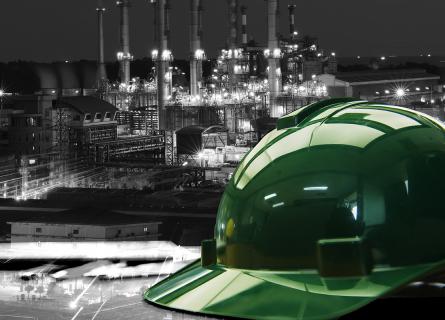
Digitalising industrial safety towards ‘100% safe’ with VR
How to make safety an embedded part of a company’s culture?
When safety is on the top of the agenda in most industrial companies, how is it still possible to have over 100,000 occupational accidents every year in Finland? In our opinion, the main reason is the lack of risk assessments at one’s own working environment and the general nature of safety training.
Luckily, today’s technology enables us to take all advantages of existing 3D models, enriched with laser scanning or aerial photogrammetry and create an interactive 360° environment, where different safety features and scenarios can be easily tested and demonstrated.
Nearly 130,000 accidents at work occurred in Finland in the year 2017, of which about 80 percent were occupational accidents, and about 20 percent were commuting accidents between home and work. (Centre for Occupational Safety, 2017).
How to make safety issues visible and noticeable in everyday work?
Safety engineering shall be embedded in a company’s culture and included in every investment phase from planning to start-up, maintenance and operation. OurVirtual Site Designer (VR) is a well-proven solution to engage all stakeholders and bring safety as a natural part of everyday work. Operators, maintenance managers and other employees can present comments on safety solutions with Virtual Reality s during design, and see the impact of these in a virtual environment exactly as in a real plant.
If safety solutions are not connected with up-to-date plant information and safety training is in a generic environment, which may cause resistance within operators, maintenance and other stakeholders. Virtual Reality makes it possible to integrate all site information to one realistic virtual model of a specific site.
How Virtual Reality can improve plant safety
Risk analysis
With Virtual Reality it is possible to implement HAZOP or ATEX or other process risk analyses from multiple locations simultaneously. For example, it is possible to participate to the analysis of local offices, cost effectively and safely without travelling. During analysis, it is possible to analyse different scenarios and escape routes. In fire risk analysis, the potential locations for pool fires can be reviewed. The existing and future locations of safety showers and other safety equipment and systems can also be reviewed from the VR model.
Hazardous area classification
Classified ATEX spaces can be shown in the Virtual Reality model. All necessary safety-related markings in an explosive atmosphere, such as signs of EX, boundaries of an explosive space, signs of naked flames and a ban on smoking or the use of a cell phone are clearly visible in the model. This information can be utilised for maintenance planning, orientation & training, as well as checking with procurement whether new equipment needs to be ATEX equipment or not.
Consequence analysis
When modelling consequences of a scenario, Virtual Reality can be utilised in many ways. The topography of a plant may be checked from the VR model and estimations made where the possible leakage would drift or show spreading modelled with CFD (Computational Fluid Dynamics). The modelling of e.g. gas cloud explosions or fire can be done at the most probable location in detail, while other possible locations for the accident are also taken into account. After the modelling, the results can be shown in the VR model. Distances to the specified heat radiation or overpressure levels or distances for dispersion of a toxic substance can be checked from the model. All necessary information like fire classes of the structures or locations of escape routes and safety showers are visible in the model. We use DNV GL’s Phast consequence modelling software which is considered as the most accurate software used for the consequence modelling in the process industry.
Safety training
Realistic virtual training environments offer safety and accuracy for training. In Virtual Reality, you always have a training environment available to be used either alone or using the multisession feature. Training in our Virtual Site Designer environment is efficient – it can be done outside the mill area which saves time in travelling. The training environment is always uniform for all employees around the company, with modified training for visitors and contractors if needed. Guidelines, warnings and tests can be added to the training model.
Maintenance – increasing the overall safety
All site visits are potential risks. Total safety increases when unnecessary maintenance planning visits can be avoided and the Virtual Reality model is utilised in planning work phases of maintenance. The Virtual Reality model shows safe routes, necessary tools as well as warnings. For example, maintenance can utilise VR in making risks assessments on equipment, without opening any equipment beforehand. Also the dimensions for the new equipment or future maintenance operations can be planned beforehand. Maintenance operators can check the site from the VR model beforehand to ensure safe transportation of equipment and routes to the location. For example it is good to check that cranes fit at the location and can operate safely.
Safety audits
While doing safety audits on site, any deviations can be allocated to the right place by inserting a note into the Virtual Reality model via the interactive pad. This ensures the deviations are marked immediately to be modelled, they are visible for all VR users, and are easy to trace afterwards. This will enable faster handling of corrective actions.
Our solutions
Our global network of experts has the best possible understanding of local circumstances and we continuously follow safety legislation and regulations. We provide a one-stop shop for all safety services, from auditing, to implementation across the industry, energy and infrastructure sectors.
The Virtual Site Designer is an interactive Virtual Reality solution developed by combining advanced technologies such as laser scanning, aerial photogrammetry and 3D engineering modelling to get all the details of the environment close to reality. The application is based on a Unity game engine which offers user-friendly and agile customer experience.




